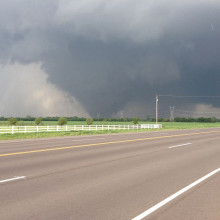Tragedy struck Oklahoma this week, when a massive tornado at least a mile wide ripped through the town of Moore, injuring 353 and leaving at least 24 people dead. To find out how these destructive forces of nature develop, here's your Quickfire Science of tornadoes with Elena Teh and Pete Skidmore...
In this episode

00:00 - Quickfire Science: Oklahoma Tornado
Quickfire Science: Oklahoma Tornado
Tragedy struck Oklahoma this week, when a massive tornado at least a mile wide ripped through the town of Moore, leaving at least 24 people dead. Here's your Quickfire Science on these destructive forces of nature:
Pete - A tornado is a rapidly rotating column of air, which descends from the base of a thunderstorm down to the ground.
Elena - The most powerful tornadoes often form underneath large rotating thunderstorms, called supercells.
Pete - There are several theories about how tornadoes form under a supercell, but one possible way is from wind shear. This is when winds at two different heights blow in different directions or at different speeds.
Elena - The clash between these two winds can cause a cylinder of air to rotate around a horizontal axis, which can then be tilted vertically towards the ground by warm air rising within the thunderstorm.
Pete - Given the right conditions, this vertical spinning cylinder of air can become a tornado.
Elena - Tornadoes occur all over the world, but most commonly form in North America, especially in the central plains of the United States, nicknamed Tornado Alley.
Pete - Scientists think they are so frequent here because warm, rising air from the Gulf of Mexico is focussed into thunderstorms by cool, dry air from Canada. Dry winds blowing east from the Rocky Mountains provide the wind shear which drives the rotation of the storms.
Elena - Modern methods of detecting tornadoes include using satellite data as well as radar to identify the high wind speeds.
Pete - The US National Weather Service's Storm Prediction Center uses these new techniques, as well as a network of voluntary storm spotters across the country, to provide a tornado warning system to communities at risk
Elena - Warnings for Monday's disaster in Oklahoma were sent out 16 minutes before the twister hit the ground, earlier than the average time of 8 to 10 minutes.
Pete - The strength of a tornado is measured from 1 to 5 on the Enhanced Fujita scale, which looks at the amount of damage caused to structures.
Elena - The Oklahoma tornado had an Enhanced Fujita score of 5, the most powerful rating, with wind speeds of over 200 miles per hour giving it the power to sweep away strong buildings and overturn cars.
- Previous Do plants get jetlag?
- Next Cathinone: Chemistry in its element









Comments
Add a comment